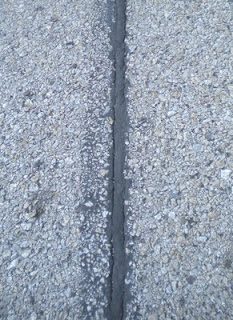 |
| No Danger from This Crack |
 |
| No Danger from Filled Crack |
On Facebook, one comment in response to my "
wet weather experiments" alluded to my interest in cycling science. There's not a lot of science to riding in the wet weather, though some experiments are in order to work out particulars for a particular situation. Things were prompted more by the observation, BY THE SAME COMMENTER, about how
the safest cyclists are those that ride every day, under all conditions. I truly believe that to be the case. My interest was further piqued by an observation John Forester made in one of his books (I think it was
Bicycle Transportation) about how cyclists learn how to ride in the conditions that prevail in their area. Put both of those together and you get wet weather experimentation. Back in February, you got ice riding in North Texas.
However, even I have limits to my scientific curiosity about cycling conditions. Lately, the City of Bedford has been digging out cracks on some of the streets along my commute route. Some of these cracks run in the direction of travel. Scientific curiosity has caused me to wonder if these not-yet-repaired cracks might represent a diversion fall danger to cyclists. We're not talking about any danger to someone riding on wide tires, but on the narrower tires used on road bikes. What's more, those cracks are not like railroad tracks, but just wide enough to leave the question in doubt. The cracks below are just about the same width as the rim on a road bike. My 28c tires are PROBABLY OK. 23c? Who knows?
 |
| Might This Crack Cause a Fall? |
As the week progressed, no doubt prompted by too much time watching those cracks sweep by, I briefly considered the experiment of riding across the cracks at a shallow angle just to see what would happen to my 28c wide tires. Thankfully, sanity quickly returned and I decided to leave the experiment to someone younger and less foolish than myself. I have suffered a diversion fall in the past (
distant past), and suffering another just to see if it would occur didn't seem real wise. Regardless, a warning sign about the unfilled cracks might have been a nice gesture from the city.
 |
| More Unfilled Cracks - Being Chicken, I Avoid Answering the Fall Question |















4 comments:
It's true that a narrow tire could drop into the cracks. But there's another hazard: If your're riding a wider tire with raised treads, the edge of the crack can catch the edge of the treads and cause you to fall. I've seen it happen to cyclists on mountain bikes with fat tires.
Riding skinny tires causes me to be much more aware of potential riding hazards.
Little things that I would often ignore with 38s or 35s now need my full attention.
I often wonder if that's a good or bad thing, the fact that I seem to have to scrutinize every square foot of road ahead.
As opposed to just enjoying my ride.
That looks like a pretty narrow crack and difficult to get jammed up in unless you got it perfectly right, i.e., perfectly parallel and dropped in with a very narrow tire.
But one thing we do in geosciences is to put something for scale in a picture like that, such as a quarter or the camera lens cover.
Wheels follow eyes. Eyes seek novelty and signs of possible danger. Brain wants to evaluate possible danger. Hey, that crack is new! How wide is it? Wider than my tire? I- uh oh.
Post a Comment
No Need for Non-Robot proof here!